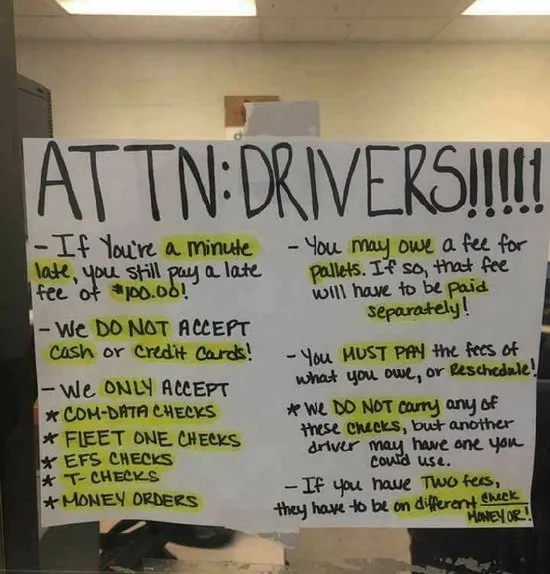A term that’s been popularized is “shipper of choice.” A shipper of choice is just as it sounds, a shipper that carriers choose to do business with. Being a shipper of choice can mean the difference between your freight moving faster and at a more reasonable rate than your competitor. In fact. there are few greater competitive advantages your transportation department can achieve than being recognized as one.
The good news is that becoming a shipper of choice is almost entirely your choice. Ben Graeff, Chief Operating Officer as FreightPlus joins us to discuss what it means to be a shipper of choice.
What does it mean to be a shipper of choice?
“To become a shipper of choice you need to be a lot more carrier facing,” said Graeff. “The days of beating up the carriers are long gone.”
Traditionally, shippers have treated carriers interchangeably and relationships have been transactional.
“We’re encouraging our clients to become more proactive with their carriers.” Graeff advised. “It’s really not a commodity service anymore. We really need to, as shippers, become a lot more in-tune to the struggles that drivers have.”
Addressing issues that carriers and truckers have is the key to becoming a shipper of choice, but what are some of those issues?
Time
“There is a clear opportunity to free up capacity and that just all ties back in to time. So, if you have a driver that doesn’t have clear instructions on your own facility – where are the dock doors, any specific appointment and payment requirements, what are the PO requirements, what are your shipping and receiving times. If they don’t have a clear understanding of this – even 15, 20, 30 minutes extra that that driver has to spend at your facility, at the end of the day, it all adds up.”
Carriers are taking note too. With ELDs now in every truck, carriers know exactly how long their drivers are being detained for.
“If a driver can drive for 11 hours, based on the hours of service regulations, now you’ve taken 1 hour out of that? You’ve almost looped off 10% of capacity right there.”
As the adage goes: time is money. Each minute that a trucker is stuck at a shipper’s facility is time off the road and time where they can’t be hauling new shipments. Shippers who are known to cost carriers money with excessive wait times are having their contracts ripped up and their calls for new shipments ignored.
“My company has ripped up a few different contracts with a few different shippers over how they treat the driver, over improper dock times, improper dock set-up. Things like that. With the implementation of ELDs time is money. Now more than ever,” said Paul Charles, a veteran truck driver for Dedicated.
Step 1 to becoming a shipper of choice: Keep the trucks moving. If that requires an investment in more dockhands, forklifts, operators, ASRS, and/or docks and doors, than shippers should be encouraged to do so. Not only will these investments elevate your status among carriers, but they will pay dividends throughout your supply chain by improving overall dock efficiency.
Parking
Since truckers must operate within an hours of service window and can’t manipulate their log books, facilities where a trucker can shut down for the night are favored by carriers.
“There’s a shortage of trucker available parking in the US where they can shut down for the night and get some sleep. If you have available parking on site, believe me, that’s a huge benefit. We’ve looked at some other studies. If carriers are creeping up on their 9th hour of drive time and they know that there’s a facility where they can stop for the night, right where they are – they’re going to shutdown for the night and remove those 2 hours from capacity,” said Graeff.
Step 2 to becoming a shipper of choice: Be driver friendly. Lots that are turning drivers away who are near their hours of service limit are highly unlikely to be shippers of choice.

Basic Amenities
Truckers spend excessive amounts of time behind the wheel of their big rigs. After traffic delays, as well as long wait times and check-ins, they need access to basic amenities.
“Have a sink and a bathroom, really that’s all we ask,” said Charles
Step 3 to becoming a shipper of choice: At the very least, have clean, unlocked bathrooms. For an even better standing with carriers, include vending machines, a breakroom, and free wifi. Remember, the happier your driver is, the happier the carrier will be.
Flexibility
The roads are congested, and traffic is only getting worse. Carriers are often open to exploring new ways to create capacity by working with shippers who have flexible delivery days and hours.
“A key one that we’ve heard back consistently from carriers is, any off-hour or weekend availability – just having that flexibility – helps out so much,” advised Graeff.
Flexibility doesn’t just apply to hours of operation, but also to how cargo is received. Drop-and-hook operations will move a driver along much faster than a live load, for example.
Technology
“This allows a driver to leave 3 or 4 empty trailers in your yard. You can fill them up and he can pick it up while dropping a new empty container. Then it’s just a signature. Now my driver can come in-and-out.”
Step 4 to becoming a shipper of choice: Customer service works both ways and shippers who accommodate carriers are being rewarded. Nighttime, weekend, and off-peak delivery hours will curry favor with any carrier as will eliminating detention times with drop-and-hook operations.
Communication is key and the language of the 21st century is technology. Carriers are demanding visibility. Visibility enables carriers (and shippers) to react in real time and helps to prepare for future loads.
“Now, more than ever is the time you should be looking into a transportation management system. This, because it’s technology driven, is going to increase the predictability of loads for the carriers. So, they’re going to have greater visibility further upstream. They’re going to be able to plan their routes and drivers better. It’s going to take away situations where drivers are showing up and no loads are ready.”
Step 5 to becoming a shipper of choice: Be visible and predictable. There’s no greater way to achieve those levels of load planning than with technology and a transportation management system. These cost-reducing and time-saving efficiencies are paramount to getting to the top of any carrier’s list.
On-time payment
Shippers are used to paying their supply chain partners on net 30, net 60, or net 90 terms. This applies to ocean carriers, suppliers, etc. It’s also the way that they’d like to pay their inland carriers as well. The problem is that the truck carrier industry has numerous upfront costs such as fuel, driver pay, and maintenance. More and more carriers are electing to work with shippers that can honor their terms (not yours), which usually means paying the carrier immediately.
“If we’re paying our carriers, on average, in 90 days – if you look at it from a carrier facing standpoint – the invoice that they’re paying on, like investments in equipment, 70% of those invoices are due in less than 10 days. So, we’re looking at a complete mismatch there on how long it takes (shippers) to compensate the carriers and how long the carriers have to pay their invoice. There’s a very big disconnect there as well.”
Additionally, forcing drivers to pay fees and fines at the receiver’s dock is a practice that carriers would like for shippers to end. Rather, many carriers would prefer that you invoice their accounting department instead of their driver. This would also help expediate wait times as drivers aren’t forced to look for checks or waste time getting money orders just to keep their wheels moving.
Step 6 to becoming a shipper of choice: Accelerate your payment cycle and let carriers know that you’re willing to pay on net 10 terms or less. Use a transportation management system to track billing and have any invoices handled by your respective accounting departments instead of disrupting freight flow at the time of delivery.
The Golden Rule
The same concept that should apply to all relationships works here as well. Treat others as you’d like to be treated. Logistics is a business of relationships and your carrier is a vital link in your supply chain.
“It’s just the golden rule. It’s a basic rule of humanity. I’m going to treat everybody, regardless of their profession, the way that I expect to be treated. I don’t think that it would be asking a lot of folks to say, ‘please’ and ‘thank you.’ Basic common courtesy. You really need to focus on building your relationships with your carriers and their drivers.”
Step 7 to becoming a shipper of choice: Work with your carriers as you would with your other business partners. Accommodate their employees and recognize the challenging work that they undergo to ensure that your freight arrives in a timely fashion. Oh, and leave the bathroom door unlocked.
Summation
Becoming a shipper of choice is a decision. It’s a shipper’s choice to not only improve their standing with carriers, but to improve their own internal efficiencies. Nearly all the steps involved benefit both parties.
Or as Ben Graeff states:
“There isn’t any one thing that you can do to become a shipper of choice. It’s a combination of a number of small things that together will give you that competitive advantage. First and foremost, abide by that golden rule. Make sure that we’re treating our carriers with respect. Have open and honest communications with them. Collaborate with your carriers. You’re not mandating to them what they need to do. Increase your turn times at your facility. Time is money, for these guys. And, be willing to have an open and honest look at what’s happening within your four-walls. Be flexible with your delivery times and payment terms.”
Ben left us with one final piece of advice.
“Lastly, if you haven’t made an investment in a transportation management system – now is the time to do it!”
LTL Negotiations White Paper
Download our LTL NegoTIATIONS WHITE PAPER today
The goal of any Less-Than-Truckload (LTL) negotiation is to source carriers that will provide great service to your freight, your facilities, your customers, and your suppliers at a fair market price.
However, shippers typically run into trouble when negotiating because they lack the information on how it operates.
To help, we’ve created a white paper on the best practices our experts have accumulated over our 30 years in logistics.
In this guide you will learn:
- The carriers’ operations and needs
- The freight data to collect
- Tips and tricks for negotiating
SIGN UP TO RECEIVE LTL NEGOTIATIONS WHITE PAPER



